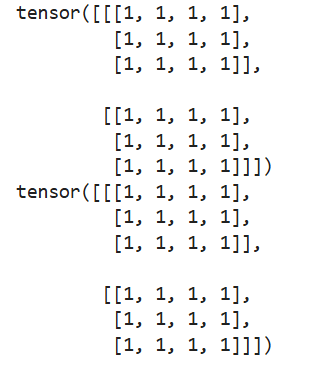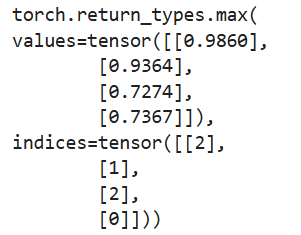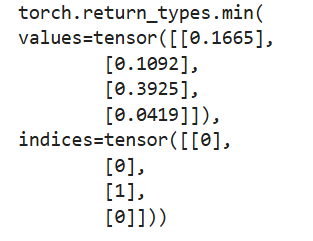张量(Tensor)是PyTorch最基本的操作对象。在几何定义中,张量是基于标量、向量和矩阵概念的眼神。通俗理解,可以讲标量视为0维张量,向量视为1维张量,矩阵视为2维张量。在深度学习领域,可以将张量视为一个数据的水桶,当水桶中只放一滴水时就是0维张量,多滴水排成一排就是1维张量,联排成面就是2维张量,以此类推,扩展到n维向量。
张量的数据类型
PyTorch中创建张量的方法有两种,一种是通过Python数组创建,另一种是从列表中创建。创建张量的代码如下:
import torch
# 从python数组构建
a = [[1, 2, 3],[4, 5, 6]]
x = torch.Tensor(a)
print(a, x)
# 从列表构建张量
x = torch.Tensor([[1, 2]])
print(x)
torch.rand()函数
torch.rand()函数的用法为torch.rand(\*sizes,out=None)->Tensor,返回一个张量,服从区间为[0,1)的均匀分布,形状有参数sizes定义,代码如下:
tensor1 = torch.rand(4)
tensor2 = torch.rand(2, 3)
print(tensor1, tensor2)
torch.randn()函数
torch.randn()函数的用法为torch.randn(*size,out=None)->Tensor,返回一个张量(高斯白噪声),服从均值为0,方差为1的标准正态分布,形状由参数sizes定义,代码如下:
tensor1 = torch.randn(5)
tensor2 = torch.randn(2, 4)
print(tensor1, tensor2)
torch.normal()函数
torch.normal()函数的第一种用法为torch.normal(means, std, out=None)。
如果没有size参数,返回一个张量,服从指定均值means和标准差std的正态分布,均值means是一个张量,包含每个输出元素相关的正态分布的均值。标准差std是一个张量,包含每个输出元素相关的正态分布的标准差。均值和标准差的形状无需匹配,但每个张量的元素须相同。
tensor = torch.normal(mean=torch.arange(1., 11.), std= torch.arange(1, 0, -0.1))
print(tensor)
torch.arange(1, 0, -0.1)
tensor = torch.normal(mean=0.5, std=torch.arange(1., 6.))
print(tensor)
tensor = torch.normal(mean=torch.arange(1., 6.), std=1.0)
print(tensor)
torch.normal()的第二种用法为torch.normal(mean, std, size*, out=None),共享均值和方程
tensor = torch.normal(2, 3, size=(1, 4))
print(tensor)
该代码中产生的所有的数服从均值为2,方差为3的正态分布,形状为(1,4)
torch.linspace()函数
torch.linspace()函数的用法为torch.linspace(start,end,step=100,out=None)->Tensor,返回一个1维张量,包含在区间start和end上均匀间隔的steps个点。
tensor = torch.linspace(1, 10, steps=5)
print(tensor)
torch.manual_seed()函数
torch.manual_seed()函数用于固定随机种子,下面生成的随机数序列都是相同的,仅作用于最接近的随机数产生语句。
torch.manual_seed(1)
temp1 = torch.rand(5)
print(temp1)
torch.manual_seed(1)
temp2 = torch.rand(5)
print(temp2)
temp3 = torch.rand(5)
print(temp3)
temp1和temp2是相同的,temp3是不同的,因为seed仅作用于最接近的那句随机数产生语句。torch中toech.seed()函数没有参数,用来将随机数的种子设置为随机数,一般不使用。
torch.ones()、torch.zeros()、torch.eye()
torch.ones()函数用来生成全1数组,torch.zeros()函数用来生成全0数组,torch.eye()函数用来生产对角线为1,其余部分全为0的二维数组。
tensor1 = torch.zeros(2, 3)
tensor2 = torch.ones(2, 3)
tensor3 = torch.eye(3)
print(tensor1, tensor2, tensor3)
在PyTorch中默认的数据类型为32位浮点型(torch.FloatTensor),如果想要规定张量的数据类型,可以在创建时指定类型,或者创建完之后对张量的数据类型进行转换。
# 第一种方法:在创建张量时指定数据类型
x = torch.ones((2, 3, 4), dtype=torch.int64) # 生成全1数组
print(x)
# 第二种方法:张量创建完成后,对数据类型进行转换
x = torch.ones(2, 3, 4) # 生成全1数组
x = x.type(torch.int64)
print(x)
张量的基本操作
PyTorch中,张量的操作分为结构操作和数学运算,结构操作就是改变张量本身的结构,数学操作就是对张量的元素值进行数学运算。常用的结构操作包括改变张量的形状、增加和删除维度、交换维度、拼接和分隔、堆叠和分解、索引和切片,数学运算包括基本数学运算、向量运算、矩阵运算。
torch.view()函数可以改Tensor的形状,但是必须保证前后元素总数一致。
x = torch.rand(3, 2)
print(x.shape) # torch.Size([3, 2])
y = x.view(2, 3)
print(y.shape) # torch.Size([6])
增加和删除维度
unsqueeze()函数可以对数据维度进行扩充,给指定位置加上维度为1的维度。用法:torch.unsqueeze(a,N),或者a.unsqueeze(N),在a中指定位置N加上一个维度为1的维度。
# 增加维度
a = torch.rand(3, 4)
b = torch.unsqueeze(a, 0)
c = a.unsqueeze(0)
print(b.shape)
print(c.shape)
squeeze()函数可以对张量进行维度的压缩,去掉维数为1的维度。用法:torch.squeeze(a)将a中所有维数为1的维度都删除,或者a.squeeze(1)是去掉a中指定维数为1的维度。
# 删除维度
a = torch.rand(1, 1, 3, 4)
b = torch.squeeze(a)
c = a.squeeze(1)
print(b.shape)
print(c.shape)
交换维度
在运用各种模型的过程中,经常会遇到交换维度的问题。PyTorch中有两种交换维度的方法。torch.transpose()函数用于交换两个维度,torch.permute()函数可以自由交换任意位置。
a = torch.rand(1, 3, 28, 32) # torch.Size([1, 3, 28, 32]
# 第一种方法
b = a.transpose(1, 3).transpose(1, 2) # torch.Size([1, 28, 32, 3])
print(b.shape)
# 第二种方法
c = a.permute(0, 2, 3, 1)
print(c.shape) # torch.Size([1, 28, 32, 3])
拼接和分割
可以用torch.cat()函数将多个张量合并,torch.cat()函数是链接,不会增加维度;也可以用torch.split()函数把一个张量分割为多个张量。torch.split()函数可以看做torch.cat()函数的逆运算。split()函数的作用是将张量拆分为多个块,每个块都是原始张量的视图。
# torch.cat()拼接方法的代码如下:
a = torch.rand(1, 2)
b = torch.rand(1, 2)
c = torch.rand(1, 2)
output1 = torch.cat([a, b, c], dim=0) # dim=0为按列拼接
print(output1.shape) # torch.Size([3, 2])
output2 = torch.cat([a, b, c], dim=1) # dim=1为按行拼接
print(output2.shape) # torch.Size([1, 6])
# torch.split()分割方法的代码如下:
a = torch.rand(3, 4)
output1 = torch.split(a, 2)
print(output1)
output2 = torch.split(a, [2, 2], dim=1)
print(output2)
堆叠和分解
可以用torch.stack()函数将多个张量合并,torch.stack()函数和torch.cat()函数有略微的差别,torch.stack()函数用于进行堆叠操作,会增加一个维度。torch.chunk()函数可以看做torch.cat()函数的逆运算。torch.chunk()函数的作用是将Tensor按dim(行或列)分割成chunks个Tensor块,返回的是一个元组。
# torch.stack()堆叠方法
a = torch.rand(1, 2)
b = torch.rand(1, 2)
c = torch.rand(1, 2)
output1 = torch.stack([a, b, c], dim=0) # dim=0为按列拼接
print(output1.shape)
output2 = torch.stack([a, b, c], dim=1) # dim=1为按行拼接
print(output2.shape)
# torch.chunk()分解方法的代码如下:
a = torch.rand(3, 4)
output1 = torch.chunk(a, 2, dim=0)
print(output1)
output2 = torch.chunk(a, 2, dim=1)
print(output2)
索引和切片
Torch张量的索引以及切片规则与Numpy基本一致,比较简单。
x = torch.rand(2, 3, 4)
print(x[1].shape)
y = x[1, 0:2, :]
print(y.shape)
z = x[:, 0, ::2]
print(z.shape)
基本数学运算
张量基本的数学运算包括张量求和、张量元素乘积、对张量求均值、方差和极值。
元素求和
按元素求和的第一种方法为torch.sum(input)->float,返回输入向量input中所有的元素的和。
# 元素求和第一种方法
a = torch.rand(4, 3)
b = torch.sum(a)
print(b) # tensor(6.4069)
按元素求和的第二种方法为torch.sum(input,dim,keepdim=False,out=None)->Tensor,其中input为输入张量,dim为指定维度,keep(bool)表示输出张量是否保持与输入张量有相同数量的维度,ruokeepdim值为True,则在输出张量中,出了被操作的dim维度值降为1,其他维度与输入张量input相同。否则,dim维度相当于被执行torch.squeeze()维度压缩,导致此维度消失,最终输出张量会比输入张量少一个维度。
# 元素求和第二种方法
a = torch.rand(4, 3)
b = torch.sum(a, dim=1, keepdim=False)
print(b, b.shape)
按索引求和
按索引求和是指按索引参数index中所确定的顺序,将参数张量Tensor中的元素与执行本方法的张量的元素逐个相加。参数Tensor的尺寸必须严格执行方法的张量匹配,否则会发生错误。按索引求和的方法为torch.Tensor.index_add_(dim,index,tensor)->Tensor,dim为索引index所指向的维度,index为包含索引数的张量,Tensor为含有相加元素的张量。
# 按索引求和,不常用
x = torch.Tensor([[1, 2],[3, 4]])
y = torch.Tensor([[3, 4],[5, 6]])
index = torch.LongTensor([0, 1])
output = x.index_add_(0, index, y)
print(output)
元素乘积
元素乘积的第一种方法为torch.prod(input)->float,返回输入张量input所有元素的乘积。
# 元素乘积第一种方法
a = torch.rand(4, 3)
b = torch.prod(a)
print(b)
元素乘积的第二种方法为torch.prod(input,dim,keepdim=False,out=None)->Tensor,其中input为输入张量,dim为指定维度,keepdim(bool)表示输出张量是否保持与输入张量有相同数量的维度,若keepdim值为True,则在输出张量中,除了被操作的dim维度值降为1,其他维度与输入张量input相同。否则,dim维度相当于被执行torch.squeeze()函数进行维度压缩操作,导致此维度消失,最终输出张量回避输入张量少一个维度。
# 元素乘积第二种方法
a = torch.rand(4, 3)
b = torch.prod(a, 1, True)
print(b, b.shape)
求平均数
求平均数的第一种方法为torch.mean(input),返回输入张量input中每个元素的平均值。
# 求平均数的第一种方法
a = torch.rand(4, 3)
b = torch.mean(a)
print(b)
求平均数的第二种方法为torch.mean(input,dim,keepdim=False,out=None),其中参数的含义与元素求和、元素乘积的含义相同。
# 求平均数的第二种方法
a = torch.rand(4, 3)
b = torch.mean(a, 1, True)
print(b, b.shape)
求方差
求方差的第一种方法为torch.var(input,unbiased=True)->float,返回输入向量input中所有元素的方差,unbiased(bool)表示是否使用基于修正贝塞尔函数的无偏估计。
# 求方差的第一种方法
a = torch.rand(4, 3)
b = torch.var(a)
print(b)
求方差的第二种方法为torch.var(input,dim,keepdim=False,unbiased=True,out=None)->Tensor,unbiased(bool)表示是否使用基于修正贝塞尔函数的无偏估计,其余参数含义与元素求和、元素乘积含义相同。
# 求方差的第二种方法
a = torch.rand(4, 3)
b = torch.var(a, 1, True)
print(b, b.shape)
求最大值
求最大值的第一种方法为torch.max(input)->float,返回输入张量所有元素的最大值。
# 求最大值的第一种方法
a = torch.rand(4, 3)
b = torch.max(a)
print(b)
求最大值的第二种方法为torch(input,dim,keepdim=False,out=None)->(Tensor,LongTensor),返回新的张量input中指定维度dim中每行的最大值,同时返回每个最大值的位置索引。
# 求最大值的第二种方法
a = torch.rand(4, 3)
b = torch.max(a, 1, True)
print(b)
求最小值
求最小值的第一种方法为torch.min(input)->float,返回输入张量的最小值。
# 求最小值的第一种方法
a = torch.rand(4,3)
b = torch.min(a)
print(b)
求最小值的第二种方法为torch.min(input,dim,keepdim=False,out=None)->(Tensor,LongTensor),与求最大值的第二种方法类似。
# 求最小值的第二种方法
a = torch.rand(4, 3)
b = torch.min(a, 1, True)
print(b)
向量运算和矩阵运算
向量的线性代数运算包括点乘(dot(a,b))、内积(inner(a,b))、叉乘(matmul(a,b))等。
向量的点乘
向量的待你橙又称为向量的内积或数量积,对两个向量执行点乘运算,就是对这两个向量对应位一一相乘之后求和的操作。
# 向量的点乘,a和b必须为一维
a = torch.Tensor([1, 2, 3])
b = torch.Tensor([1, 1, 1])
output = torch.dot(a, b)
print(output) # 等价于 1*1+2*1+3*1,tensor(6.)
向量的叉乘
两个向量的外积,又叫叉乘、叉积向量积,其运算结果是一个向量而不是一个标量。
# 向量的叉乘
a = torch.Tensor([1, 2, 3])
b = torch.Tensor([1, 1, 1])
output = torch.multiply(a, b)
print(output)
矩阵的内积
两个维度相同的矩阵a和b,a和b矩阵的内积是相同位置的向量的内积。
# 矩阵的内积
a = torch.Tensor([1, 2, 3])
b = torch.Tensor([1, 1, 1])
output = torch.inner(a, b)
print(output)
矩阵的外积
矩阵的外积就是通常意义的一般矩阵乘积。一般矩阵乘积是矩阵相乘最重要的方法,它只有在第一个矩阵的列数(column)和第二个矩阵的行数(row)相同时才有意义。
# 矩阵的外积:矩阵乘法
a = torch.Tensor([[1, 2, 3], [4, 5, 6]])
b = torch.Tensor([[1, 1], [2, 2], [3, 3]])
output = torch.matmul(a, b)
print(output)
# 按批量相乘
a = torch.randn(10, 3, 4)
b = torch.randn(10, 4, 5)
output = torch.bmm(a, b)
print(output.shape)
# tensor([[14., 14.],
# [32., 32.]])
torch.einsum():爱因斯坦求和约定是一个非常神奇的函数,号称可以满足你的一切需求!功能强大,
张量与Numpy数组
由于使用Numpy中ndarray处理数据非常方便,经常会将张量与Numpy数组进行相互转换,所以掌握两者之间的转换方法很有必要。但是需要注意一点:相互转换后所产生的张量和Numpy中的数组共享相同的内存(所以他们之间的转换很快),改变其中一个时另一个也会改变。将张量转换为Numpy数组使用tensor.numpy()方法,将Numpy数组转换为张量使用torch.from_numpy(ndarry)方法。
张量转Numpy数组
使用numpy()函数将张量转换成Numpy数组。
a = torch.ones(1, 2)
b = a.numpy() # 进行转换
print(a, b)
a += 2
print(a, b)
b += 2 # 在a改变后,b也已经改变
print(a, b)
Numpy数组转张量
使用from_numpy()函数将Numpy数组转换成张量。
import numpy as np
a = np.ones([1, 2])
b = torch.from_numpy(a) # 进行转换
print(a, b)
a += 2
print(a, b)
b += 2 # 在a改变后,b也已经改变
print(a, b)
Cuda张量与CPU张量
在深度学习过程中,GPU能起到加速的作用。PyTorch中的张量默认存放在CPU设备中,如果GPU可用,可以将张量转移到GPU中。CPU张量转换为Cuda张量有两种方法。一般情况下,可以使用.cuda方法将Tensor移动到GPU;在有多个GPU的情况下,可以使用to方法来确定使用哪个设备。也可以使用.cpu方法将Tensor移动到CPU。
x = torch.rand(2, 4)
print(x.device) # cpu
# 第一种方法
x = x.cuda()
print(x.device) # cuda:0
# 第二种方法
device = torch.device("cuda" if torch.cuda.is_available() else "cpu")
if torch.cuda.is_available():
x = x.to(device)
print(x.device) #cuda:0
# 转化为cpu
x = x.cpu()
print(x.device) # cpu
| NumPy从入门到放弃 | https://mp.weixin.qq.com/s/EocThNWhQlI2zeLcUApsQQ |
|---|---|
| Pandas从入门到放弃 | https://mp.weixin.qq.com/s/mSkA5KvL1390Js8_1ZBiyw |
| SciPy从入门到放弃 | https://mp.weixin.qq.com/s/MulhzVRvWbaDUjfNPHN8qA |
| Scikit-learn从入门到放弃 | https://mp.weixin.qq.com/s/L0tKz9JFnsgrzSCXDswbRA |
__EOF__
- 本文作者: 愷龍
- 本文链接: https://www.cnblogs.com/kohler21/p/18392248
- 关于博主: 评论和私信会在第一时间回复。或者直接私信我。
- 版权声明: 本博客所有文章除特别声明外,均采用 BY-NC-SA 许可协议。转载请注明出处!
- 声援博主: 如果您觉得文章对您有帮助,可以点击文章右下角【推荐】一下。



































































 被折叠的 条评论
为什么被折叠?
被折叠的 条评论
为什么被折叠?








